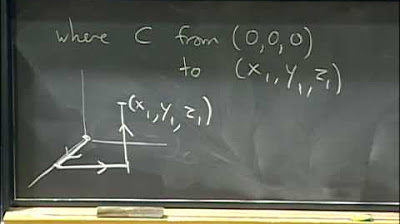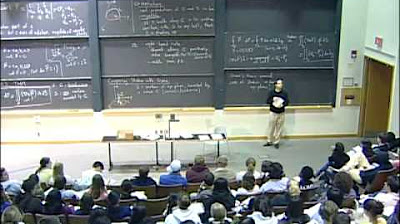Video 53 - Curl
TLDRThis video, the 53rd in a series on tensor calculus, introduces the curl, a differential operation that measures the rotational nature of a vector field. The script explains the curl's definition, its resemblance to the cross product, and how it differs by involving only a single vector and the covariant derivative. It also derives the curl's alternate form, which is simpler for practical calculations, and discusses important identities such as the curl of a gradient being zero and the divergence of the curl also being zero. The video concludes with the geometric significance of the curl, its role in identifying conservative forces, and its importance in vector field analysis.
Takeaways
- 📚 The script introduces the concept of 'curl', a differential operation in tensor calculus, which is akin to the cross product but operates on a single vector field.
- 🔍 The curl is defined by a tensor equation involving the covariant derivative and the Levi-Civita symbol, resulting in a contravariant vector component.
- 📉 The script differentiates between the curl and the cross product, noting that the curl involves a single vector and the covariant derivative, unlike the cross product which requires two vectors.
- 🔄 The curl can be represented in two forms: as a contravariant or covariant vector component, and these forms can be used interchangeably in tensor equations.
- 📝 An alternate form of the curl is derived, which is easier to evaluate in individual coordinate systems and does not involve Christoffel symbols.
- 🔑 The script demonstrates the importance of tensor properties, showing how non-tensor terms can combine to form a tensor relationship due to the skew symmetry of the Levi-Civita symbol.
- 🌀 The curl is shown to be a measure of the rotational nature or torsion of a vector field, with its direction indicating the axis of rotation and its magnitude equating to the speed of rotation.
- ❌ Two key identities are derived: the curl of the gradient of a scalar function is zero, and the divergence of the curl of any vector field is also zero.
- 🔍 The zero curl condition is identified as a test for conservative forces, where a non-zero curl indicates that a vector field cannot be a gradient of a scalar field.
- 🔧 The script concludes with the geometric significance of the curl, its role in identifying conservative force fields, and its importance in simplifying problems by allowing the representation of vector fields as gradients of scalar fields.
Q & A
What is the curl operation in tensor calculus?
-The curl is a differential operation defined by an expression involving the covariant derivative of a vector and the Levi-Civita symbol, resulting in a new vector. It quantifies the rotational nature or torsion of a vector field.
How is the curl different from the cross product?
-While the curl resembles the cross product, the main difference is that the cross product involves the product of two vectors to produce a third vector, whereas the curl operates on a single vector field using the covariant derivative.
What is the rank of the tensor resulting from the curl operation?
-The curl operation results in a tensor of rank one, specifically a contravariant vector component.
Can the curl operation be expressed in an alternate form?
-Yes, the curl can be expressed in an alternate form that is easier to evaluate in individual coordinate systems. This form involves the partial derivative of a vector component without involving Christoffel symbols.
What is the significance of the curl of the gradient being zero?
-The fact that the curl of the gradient is zero implies that if a vector field has a non-zero curl, it cannot be a gradient. This is a key property used to determine if a vector field is conservative.
What does it mean for a force field to be conservative?
-A force field is conservative if the work done to move from one point to another is the same regardless of the path taken. If the curl of the force field is zero, it indicates that the force is conservative.
How does the curl operation relate to potential energy in physics?
-If the curl of a force field is zero, it means that there is an underlying scalar field, known as potential energy, whose gradient equates to the force field. This simplifies the problem by allowing the use of scalars instead of vectors.
What is the result of taking the divergence of the curl of a vector field?
-The divergence of the curl of a vector field is always zero. This is an important identity in vector calculus and is used to test if a force field is conservative.
What is the geometric significance of the curl?
-The geometric significance of the curl is that it points in the direction of the axis of rotation of a vector field and its magnitude equates to the speed of the rotation.
Why is the curl operation important when working with vector fields?
-The curl operation is important because it helps determine the rotational nature of a vector field and is a key tool in identifying conservative forces, which simplifies the analysis of physical systems such as electricity, magnetism, and gravitation.
Outlines
📚 Introduction to the Curl Operation
This paragraph introduces the concept of the curl, a differential operation in tensor calculus. It is likened to the cross product but operates on a single vector field using the covariant derivative and the Levi-Civita symbol. The curl is explained as a tensor equation with a rank of one, which can be represented as either a contravariant or covariant vector component. The paragraph also discusses the notation commonly used for the curl and how it can be expressed in an alternate form that is more beneficial for calculations in different coordinate systems.
🔍 Derivation of the Curl's Alternate Form
The second paragraph delves into the derivation of an alternate expression for the curl, which is more advantageous for practical computation within specific coordinate systems. By expanding the covariant derivative and applying the properties of the Levi-Civita symbol, the paragraph demonstrates how the curl can be simplified to a form that excludes Christoffel symbols, making it easier to evaluate. It also addresses the tensorial nature of the curl despite the involvement of partial derivatives, which are not tensors on their own.
🔧 Important Identities Involving Curl
This paragraph focuses on deriving important identities related to the curl operation. It begins by evaluating the curl of a gradient, which is shown to be zero due to the anti-symmetry properties of the Levi-Civita symbol and the symmetry of second-order partial derivatives. The paragraph then explores the divergence of the curl, using the previously derived vector identity to demonstrate that the divergence of the curl is also zero, a key result in vector calculus.
🌀 Geometric Significance of Curl
The fourth paragraph discusses the geometric interpretation of the curl. It describes the curl as a measure of the rotational nature or torsion within a vector field, with the direction of the curl vector indicating the axis of rotation and its magnitude representing the speed of rotation. The paragraph also explains the significance of a zero curl in determining whether a vector field can be a gradient, which has implications for the conservative nature of forces in physics.
🔄 Conclusion and Recap on Curl
The final paragraph concludes the video with a recap of the curl operation, summarizing its definition, notation, and the derived identities. It emphasizes the importance of the curl in identifying conservative forces and the potential energy associated with them. The paragraph also hints at the next topic of discussion, which is integration in the context of vector fields.
Mindmap
Keywords
💡Tensor
💡Curl
💡Covariant Derivative
💡Levi-Civita Symbol
💡Contravariant Vector Component
💡Cross Product
💡Divergence
💡Christoffel Symbols
💡Gradient
💡Conservative Force
💡Potential Energy
Highlights
Introduction of the curl operation in tensor calculus.
Curl defined as a differential operation with a tensor expression.
Difference between curl and cross product highlighted.
Curl as a tensor product with a single vector and covariant derivative.
Explanation of contravariant and covariant vector components in curl.
Demonstration of lowering free indexes and swapping dummy indexes.
Curl notation in tensor equations and its resemblance to cross product.
Derivation of an alternate form of the curl for easier evaluation.
Clarification on why the curl expression is considered a tensor equation.
Derivation of the identity: curl of gradient equals zero.
Explanation of the significance of the curl of gradient being zero.
Derivation of the identity: divergence of curl equals zero.
Importance of the divergence of curl for testing conservative forces.
Geometric significance of the curl in vector fields.
Curl's role in determining if a vector field can be a gradient.
Conservative forces and their relationship with curl.
Potential energy as the scalar field associated with a conservative force field.
Recap of the video's main points on curl operation and its applications.
Transcripts
Browse More Related Video

Curl 3 | Partial derivatives, gradient, divergence, curl | Multivariable Calculus | Khan Academy

Vector Fields, Divergence, and Curl

Divergence and Curl (Vector Fields)

Curl 1 | Partial derivatives, gradient, divergence, curl | Multivariable Calculus | Khan Academy

Lec 30: Line integrals in space, curl, exactness... | MIT 18.02 Multivariable Calculus, Fall 2007

Lec 31: Stokes' theorem | MIT 18.02 Multivariable Calculus, Fall 2007
5.0 / 5 (0 votes)
Thanks for rating: